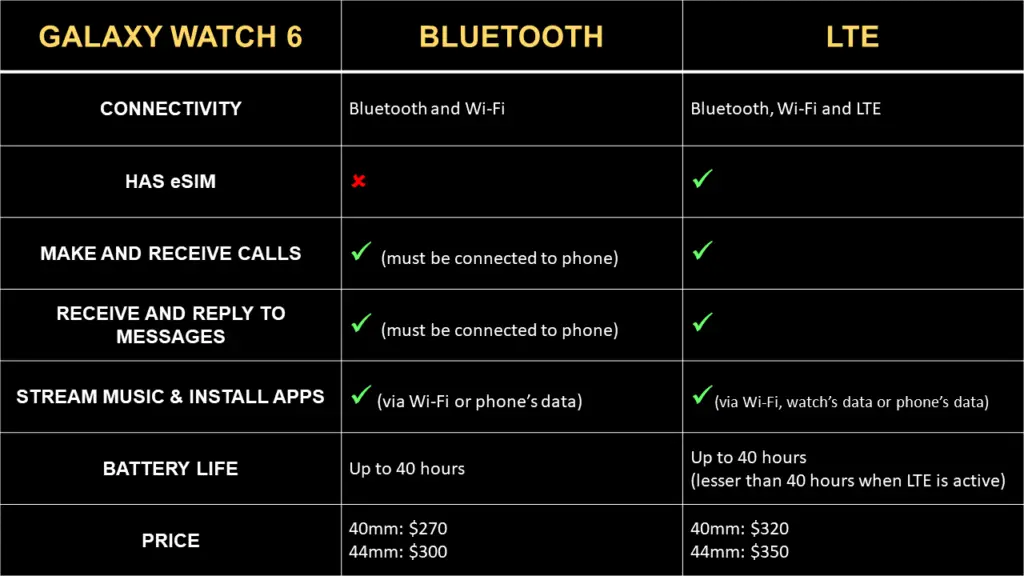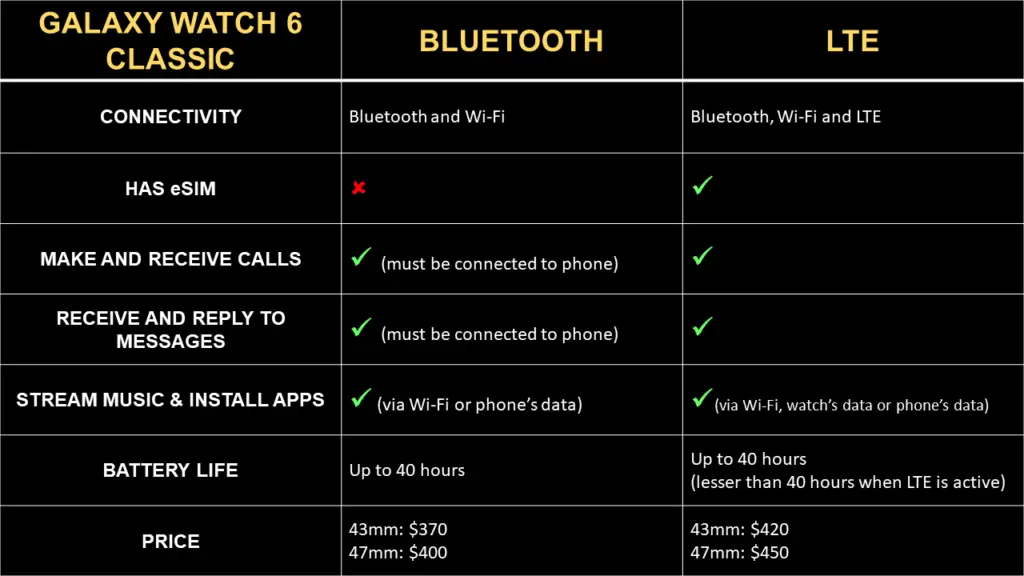Keeping up with the highly competitive smartwatch market, the Galaxy Watch 6 series alongside the Galaxy Watch 6 Classic are the latest watches from Samsung. While the Galaxy Watch 6 succeeds the very popular Galaxy Watch 5, the Galaxy Watch 6 Classic which marks a return of the physical rotating bezel succeeds the Galaxy Watch 4 Classic. The new watches launched with Wear OS 4 out of the box and welcomes a faster w930 processor and bigger displays.
Like their respective predecessors, both series come in two sizes. While the Galaxy Watch 6 series comes in 40mm and 44mm sizes, the Galaxy Watch 6 Classic comes in 43mm and 47mm sizes. Moreover, just like their predecessors, each of these sizes is available in Bluetooth and LTE models. In this post, we’ll be looking at the differences between the Bluetooth and LTE models to help you decide which is right for you.

In a few words, the difference between the two models is that the LTE model is equipped with an eSIM that enables cellular capabilities, thus it is a standalone watch that can make and receive calls and receive and reply to messages without your phone. The Bluetooth model can do all these but it must be connected to your phone. So in essence, the LTE model gives your phone some breathing space.
Galaxy Watch 5 vs 6 – What’s New?
Before we proceed further, let’s take a quick look at what’s new in the Galaxy Watch 6 and 6 Classic.

- There is a new chip with higher memory
- The display is bigger and bezel is slimmer
- Bigger battery capacities
- Galaxy Watch 6 is slimmer
The biggest feature of the Galaxy Watch 6 is the new Exynos w930 chip. This chip is a successor to the w920 chip (1.18GHz) that powers the Galaxy Watch 5 and 5 Pro. The new w930 chip boasts a faster 1.4GHz clockspeed which alongside a 2GB RAM is sure to deliver a robust performance on the Galaxy Watch 6 series. I say this with all certainty considering that in over 11 months of using the Galaxy Watch 5 Pro I haven’t experienced any glitch whatsoever.
So you can be certain to expect a blazing experience with the Galaxy Watch 6 and 6 Classic.
The Galaxy Watch 6 and 6 Classic also have bigger display sizes and as a result, the bezels are slimmer. It’s 1.5 inches for the 44mm and 47mm units and 1.3 inches for the 40mm and 43mm units of the Galaxy Watch 6 and Galaxy Watch 6 Classic respectively. The bigger display means you get to see more at a glance, and in my opinion, the slimmer bezel kind of leaves the watches with a classier and sleeker appearance.
To make up for the bigger display sizes, Samsung had to equip the Galaxy Watch 6 with bigger batteries. At least, this ensures no compromise in battery life. So, you should get about the same battery life as the Galaxy Watch 5 series. According to Samsung, you can get up to 40 hours with the Galaxy Watch 6 and 6 Classic. This is still lower than that of the Galaxy Watch 5 Pro which gives me about 3 days of battery life on average.
Interestingly, despite having slightly bigger battery capacities, Samsung has somehow managed to make the Galaxy Watch 6 and 6 Classic slimmer. Compared to the Galaxy Watch 5, the Galaxy Watch 6 is 0.8mm slimmer while the Galaxy Watch 6 Classic is 0.3mm slimmer than the Galaxy Watch 4 Classic.
Beyond these few additions, every other feature is the same. The Galaxy Watch 6 series has similar health tracking features as the Galaxy Watch 5. It’s the same Wear OS 4 and there is also a speaker and microphone in the new watches. The temperature sensor that was introduced to the Galaxy Watch 5 is also present in the Galaxy Watch 6.
Surprisingly, Samsung hasn’t deemed it necessary to upgrade storage capacity as the Galaxy Watch 6 still has the same 16GB as its predecessor. Meanwhile, close rivals like the Pixel Watch 2 has 32GB and the Apple Watch Series 9 has 64GB.
Galaxy Watch 6 Bluetooth vs LTE Full Specifications Comparison
[yith_woocompare_table products=”10422,10443,10454″]
Galaxy Watch 6 Bluetooth vs LTE – The Differences

Now that you know what’s new in the Galaxy Watch 6, let’s take a look at the difference between the Bluetooth and LTE models.
- Connectivity
- Making and Receiving Calls
- Receiving and Replying to Messages
- Installing apps, streaming music and Google Maps
- Battery Life
- Prices
One of the questions I have been asked very often is “Does the LTE model have Bluetooth?” Yes the LTE model does have Bluetooth. It’s just a naming thing. Samsung prefers to call it Bluetooth and LTE while Apple calls theirs Cellular and GPS. The appropriate naming should be cellular and non-cellular.
While the Bluetooth model relies on Bluetooth and Wi-Fi for connectivity, the LTE model relies on Bluetooth, Wi-Fi and Cellular for connectivity. The watch primarily connects to your phone via Bluetooth while Wi-Fi comes in handy for bulk transfers like updating the watch, transferring music, streaming music and installing apps. So even when LTE is not activated the LTE model will still work just like the Bluetooth model.
The ability to make and receive calls has been a prominent feature on the Galaxy watch starting from the early days of the Gear series and the iconic Galaxy Watch (the Samsung watch with the longest battery life yet). This is made possible by the presence of a speaker and microphone on the watch.
Both the Bluetooth and LTE models have microphones and speakers and can make and receive calls. However, the LTE model has an embedded SIM, and just like a phone, it doesn’t need to connect to any other device to make and receive calls. In contrast, the Bluetooth model needs your phone to make and receive calls.
So with the LTE model, you don’t need to carry your phone along to stay connected.
The cellular capabilities of the LTE model also mean that it can send and receive messages without connecting to your phone. On the other hand, the Bluetooth model must be connected to your phone to be able to receive and reply to messages.
Interestingly, irrespective of the model, LTE or Bluetooth, once you have access to a working Wi-Fi network, you can install apps, stream music and access your favorite apps like Google Assistant and Google Maps without connecting to your phone.
But what if there is no Wi-Fi network – in this case, the LTE model with LTE activated can still stream music, install apps, use Google Maps, and get answers from Google Assistant without a phone.
Another question often asked is whether the LTE and Bluetooth models have the same battery life. Well on paper, the battery capacity is the same but certainly the battery life is not the same when LTE is active.
With LTE enabled, you should expect the LTE model to have a shorter battery life compared to the Bluetooth model. So if you can get up to 40 hours of battery life with the Bluetooth model, that number will probably be around 20 to 30hrs with LTE enabled. So to get a longer battery life with the LTE model, you need to turn off LTE when your phone is nearby.
As a result of the cellular and standalone capabilities of the LTE model, it has a higher price tag than the Bluetooth model. While the 40mm unit of the Bluetooth model has a $270 price tag, the 44mm unit has a $300 price tag.
On the other hand, while the 40mm LTE model retails at $320, the 44mm unit retails for $350. So it’s a $50 markup for the extra freedom the LTE model offers.
Galaxy Watch 6 Classic Bluetooth vs LTE
Just like in the case of the Galaxy Watch 6, the difference between the Galaxy Watch 6 Classic Bluetooth and LTE models is that the latter is equipped with an embedded SIM that enables cellular connectivity, thus it can make and receive calls and send and receive messages without connecting to your phone.

Moreover, just like the Galaxy Watch 6, the LTE model of the Galaxy Watch 6 Classic has a higher price tag than the Bluetooth model. While the 43mm unit of the Bluetooth model retails for $370, it is $400 for the 47mm unit.
On the other hand, while the 43mm unit of the LTE model retails for $420, the 47mm unit has a $450 price tag. So it’s an extra $50 for the LTE.
How Does Galaxy Watch 6 LTE Work?
Like Apple cellular watches and Pixel Watch 2 LTE, the Galaxy Watch 6 LTE also supports Number share which allows the watch to share a number with your phone. This means that both the phone and watch will have the same number even though they are two different devices. As a result, both the watch and your phone must be on the same network.
For instance, if you are currently using the Verizon network on your phone, then the Galaxy Watch 6 LTE will also be on the Verizon network.
Using the same number means that while you are away from your phone and someone calls your phone number, you will receive that call on your watch.
So before you buy the Galaxy Watch 6 LTE contact your current service provider to be sure they offer a cellular plan for the Galaxy Watch 6 LTE.
Even with number share enabled, the Galaxy Watch LTE will still have its own unique number, this allows the network provider to bill you for the cellular plan provided for the watch.
And without number share, you can still activate LTE on the Galaxy Watch 6 but it won’t share a number with your phone. This means calls will be made from the Watch’s one phone number, and when there is a call to your phone it won’t show up on the watch.
Galaxy Watch 6 LTE not activating
There are many reasons why the Galaxy Watch 6 LTE is not activating, it boils down to troubleshooting what the problem might be.
- But first, note that both phone and watch must be on the same network.
- Secondly, make sure the watch is updated to the latest version. Also, check that the Galaxy Wearable is updated to the latest version.
- If you still can’t activate LTE on the Galaxy Watch, reset the watch from the Galaxy Wearable, then try activating LTE again.
- If you receive an “invalid QR code” or “QR code already used message” while trying to activate LTE, then you will need to get a new QR code from your service provider. You will need a new QR code every time you delete the network profile, reset the watch or decide to switch to another network.
- If while setting up the watch you get an error message while trying to download the mobile profile for LTE on the watch, then you need to try again. Or you can skip the process and try downloading the mobile network from the Galaxy Wearable app after pairing the watch.
The bottom line, before buying the LTE model, contact your service provider to be sure they offer a cellular plan for the Galaxy Watch 6 LTE and 6 Classic LTE. In this case, they will be able to provide some sort of assistance if you run into any issues.
Galaxy Watch 6 LTE: Supported Carriers
Even till today, many carriers across different countries are slow in adapting to the fact that LTE on a smartwatch is now a regular. I could remember in 2020 when I inquired from my network provider if they offered an LTE plan for the Galaxy Watch 3, they seemed not to know what I was talking about.
So before you decide to get the Galaxy Watch 6 LTE or Galaxy Watch 6 Classic LTE, contact your service provider to be sure they offer a data plan for the watch.
Also, there are cases where because you didn’t purchase the watch from your service provider, they end up saying they can’t activate LTE on the watch. So be sure they can activate LTE on the watch even if you purchase from Samsung or any other store.
Additionally, you should note that Galaxy Watch 6 LTE or Galaxy Watch 6 Classic LTE purchased in the UK won’t work in the US. Those meant to work in the US should be purchased in the US.
Meanwhile, in the US, supported carriers are AT&T, Verizon and T-Mobile. In Australia supported carriers include Telstra, Optus and Vodafone. In Canada, supported carriers include Rogers and Bell.
LTE or Bluetooth – Which model should you go for?
You need the LTE model if you wish to make and receive calls and send and receive messages without your phone.
If you do a lot of outdoor workouts, you need the LTE model because you might just forget your phone at home and the watch will still keep you connected. Moreover, the incidental fall detection feature can come in handy.
Seniors also need the LTE model. With the watch on your wrist, you will hardly forget it but you can always forget carrying your phone along.
However, the LTE model will cost you a little more plus a recurring monthly fee for the data plan on the watch. This is why the Bluetooth model is a popular choice.
FAQs
- Does Galaxy Watch 6 LTE have Bluetooth?
- Can I use Galaxy Watch 6 LTE without a phone?
- How can I get LTE on my Galaxy Watch 6?
- Does the Galaxy Watch 6 LTE have a SIM card?
- Can Galaxy Watch 6 receive WhatsApp calls?
- Does Galaxy Watch 6 LTE have GPS
Of course, the Galaxy Watch 6 LTE like the Bluetooth model also has Bluetooth and Wi-Fi for connectivity. The only difference is that it has an embedded SIM that enables cellular connectivity.
Yes, you can. The main difference between the LTE and Bluetooth models is that the embedded SIM in the LTE model makes it a standalone watch that can make and receive calls without a phone.
To get LTE on your Galaxy Watch 6 or 6 Classic, first, ensure your current service provider offers LTE plans for the watch. Once you have confirmed that, pair the watch to your phone. After that, open the Galaxy Wearable app, tap on Watch settings, navigate to Setup Mobile Plan and follow the system prompts to complete the process.
No the Galaxy Watch 6 doesn’t have a physical SIM card. What it has is an embedded digital SIM also called eSIM. This ensures the watch remains compact and comfortable to wear.
Both the LTE and Bluetooth models can receive WhatsApp calls. However, with the LTE model, you can receive WhatsApp calls without a phone.
Of course, it does. Like the Bluetooth model, the LTE model has an inbuilt GPS that enables the watch to map your routes during an outdoor activity.
Conclusion
There you go, both the LTE and Bluetooth models are fantastic choices, although the former is a standalone watch and thus, a more comprehensive watch.
If you have any questions, kindly drop it in the comment section and I will try to answer you as quickly as possible.

